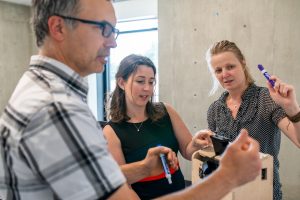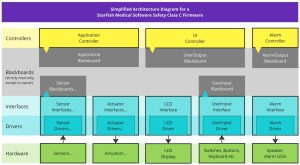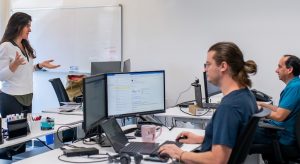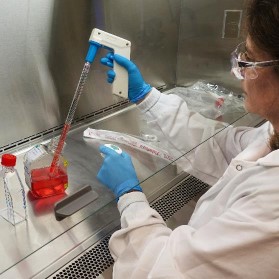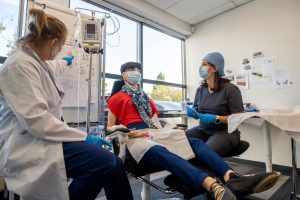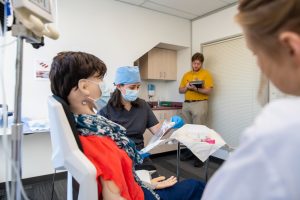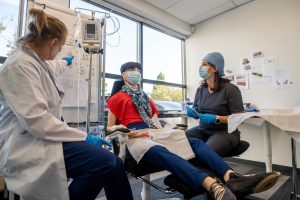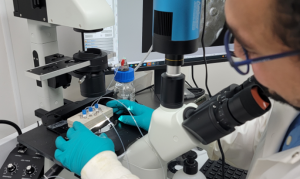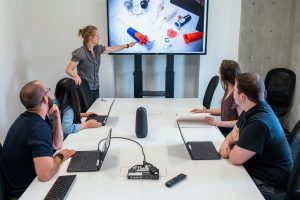 We asked our employee experts to share the traits and skills most important to their medical device development work and why they are important. The results were interesting and surprisingly soft.
We asked our employee experts to share the traits and skills most important to their medical device development work and why they are important. The results were interesting and surprisingly soft.
Read on to discover the 16 most important traits and skills to medical device development success.
Soft Skills
The skills that are most important in my ability to do my software engineering job are collaboration, systemic thinking and flexibility. While comfort and familiarity with computers and programming languages is central to my work, I’ve found that the ability to perform research is equally important.
In QA/RA, the answer is always attention to detail, we couldn’t be the precise mistake catchers if we weren’t.
Collaboration because breakthrough improvements are rarely achieved by individuals working on their own – the best solutions come from a team of diverse individuals bringing their own unique experiences to the table.
Systems thinking because it’s critical to understand how individual decisions made align with the client’s needs at every stage of the project – but the project is not merely a collection of deliverables; how those deliverables interact and affect each other within the context of the greater desired outcome is critically important.
Flexibility because project work is often not a “two hours per day allocated for the next 30 days” type of commitment; expecting the unexpected means changing gears, juggling multiple competing priorities and scheduling efficiently to ensure milestones are met.
Willingness to take risks. If you want everything to be certain when you’re developing medical devices that are novel, then you’re never going to develop them because there’s risk whenever you try something new that it is going to fail. You’ve also got to be willing to be accountable for failure and think about the next steps.
Where innovation really happens is the ability to take risks and to try something new and not be afraid to fail. Any time we fail, we learn something. And that is at the core of innovation, being able to try something that you hadn’t done before.
Find a balance to make breakthroughs in new technologies and take risks, while acknowledging the need to get to market. Creative thinking on all levels is important – technical, inter-relational, business, regulatory, and clinical aspects – as they all contribute to a successful product. The most successful programs bring core teams together, provide a challenging goal for them to work towards, and give them time and space to do their best work.
Curiosity. When you’re dealing with a variety of different medical techniques and medical devices, medical technologies, you have to be curious enough and find enough joy in learning new things to let you do your job effectively. And that excitement should be communicated to the client, who’s very passionate about their technology and skills.
Curiosity, and the corresponding ability to find answers from a broad range of sources including academic literature, device datasheets, engineering blogs, and other repositories of knowledge is one aspect of this.
Open to continual learning – the Regulatory Affairs field is ever changing, and we are always needing to keep up to date with the latest news and information and understand how it impacts our projects and our clients.
Understands where good enough becomes good enough. You can’t polish something to perfection in a finite amount of budget and time. But you need to make sure that what you’re delivering meets the requirements.
Ability to see the larger picture. Sometimes it’s easy to get lost in the minutia. We must keep our head up once in a while and look around and make sure that we’re headed down the right path. There are opportunities where we think the small goals are, maybe we can expand and really add some value. Being able to help them look down the road a way and keeping our eyes focused on the far target is helpful.
When a client comes in with a certain expectation and a certain development path, if we can show them an alternate path, we can open a larger market or a larger stream of revenue down the road for them.
Communication – both amongst peers and externally to the client. We take risks in our groups, and we need to be able to communicate how risky those decisions are. Not just to what we’re doing, but to the project in general, to the device we’re developing and to the client’s pocket. Risks can spin out of control if we haven’t done that. There are lots of tools we can use to communicate to each other and to the client. Using those judiciously is critical to keeping everyone on the same page.
Communication — how well you can present or summarize your results to other members of your team, project stakeholders, and general audiences can massively impact the trajectory of projects you work on, and whether problems you encounter are taken seriously.
Keep the door open to colleagues. Even when you’re in a sprint mode, make sure that you’re able to see the big picture in regard to what you’re contributing and what your team is contributing to sprints or the product or more generally to the effort.
Open minded to change and its value. Especially if there’s a big impact, or a wow moment you can bring to the product or to someone’s expectations. Although it might cause a headache in the short term, the long-term gains of change and change management are key. We’re learning things every day, so we don’t want to disregard important learnings along the way.
Flexible and pragmatic attitude – here in a consultancy we don’t make the same thing twice, so we need to work with the projects to understand the context of each one and help the teams and clients navigate the compliance requirements with empathy for the goals the project are trying to achieve.
Humility and a willingness to adapt. Between different projects, your title remains the same, but your roles can change dramatically. Being able to adapt to the different needs of different projects is important because on some projects, you’re pretty much driving the whole thing and on other projects you’re taking a backseat and just coming in, incidentally. Otherwise, you could create a lot of friction with the project team. Being able to understand that your role is going to be different from moment to moment when taking a lesser role, not letting that affect you. Sometimes you lead a project and later, you are the junior person on the team for the success of the project.
Be patient and persistent. Patient because people have a plateful of tasks unrelated to marketing. So, you must be patient if you want to get content. And, persistent because you have to follow up with people because they are so busy. And following up, bugging them until eventually they provide you with the content you are seeking is key.
Hard Skills
Understand how the electronics impact, and are impacted by, other disciplines. This allows me to solve the right problems in a way that meets our goals in a timely manner. One skill I’ve found particularly helpful when designing electronics is being able to understand and recognize when the problem being solved is better suited to a solution from another engineering discipline. For example, some EMC issues typically resolved in the electrical domain, can sometimes be resolved in a simpler, more cost-effective method with a mechanical solution.
Hard Vs. Soft Skills
You may have noticed almost all the answers above are soft skills. No one said be an expert in whatever your job title is. Here are some of the reasons why our experts prioritized soft traits and skills:
I’m an optical systems engineer. And so, I’d love to say what’s valuable to optical system engineers, but it’s more powerful to talk about things that I’ve noticed add value to a company, regardless of what your job title is.
We need innovators, and we need implementers. And those are two different traits. It’s hard to define what skills belong to those kinds of people. But a common trait is being able to learn something new. That’s one of our most important traits or skills because, yes, we are experts, but we don’t know everything. It’s important to be humble when you don’t know something and have the skill to pick it up and learn it and move forward.
In a previous job, we hired a physicist to do coding for Magnetic Resonance Imaging. An awesome candidate had no experience in the very specific tool that the company was using. I was just lucky enough to be part of the interview team. The hiring manager at the time said hey, we’re not looking to hire a code monkey. We’re looking to hire somebody who has the capability of achieving the end goal that you want, which is to develop something. If you see those capabilities in that person and that they’re willing to learn, adapt, and accommodate to various challenges, they can learn how to handle a specific program or how to code or CAD in a specific environment. Hard skills are not as debilitating as soft skills are. If you don’t have those, that makes you a far less valuable candidate.
Hard skills are kind of a given. It’s hard to get in the door without the hard skills, but what determines the value you bring is the soft skills over and above the hard skills. They’re more interesting because they are eminently transferable even without technical knowledge.
How many of our 16 most important traits and skills to medical device development success are priorities in your company? Which traits did we miss? We would enjoy other traits and skills from readers. Interested in working with (or in) a team that values these skills and traits? Contact us or check out our career page.
Astero StarFish is the attributed author of StarFish Medical team blogs. We value teamwork and collaborate on all of our medical device development projects.
[embedded content]
- SEO Powered Content & PR Distribution. Get Amplified Today.
- PlatoData.Network Vertical Generative Ai. Empower Yourself. Access Here.
- PlatoAiStream. Web3 Intelligence. Knowledge Amplified. Access Here.
- PlatoESG. Carbon, CleanTech, Energy, Environment, Solar, Waste Management. Access Here.
- PlatoHealth. Biotech and Clinical Trials Intelligence. Access Here.
- Source: https://starfishmedical.com/blog/16-most-important-traits-and-skills-to-medical-device-development/
- :has
- :is
- :not
- :where
- $UP
- 11
- 16
- 30
- 8
- a
- ability
- Able
- About
- above
- academic
- accommodate
- accountable
- Achieve
- achieved
- achieving
- adapt
- add
- Affairs
- affect
- afraid
- align
- All
- allocated
- allows
- almost
- along
- also
- Although
- always
- amongst
- amount
- an
- and
- Another
- answer
- answers
- any
- ARE
- around
- AS
- asked
- aspect
- aspects
- At
- audiences
- author
- auto
- BE
- because
- becomes
- before
- being
- BEST
- Better
- between
- Big
- Big Picture
- blogs
- both
- breakthrough
- breakthroughs
- bring
- Bringing
- broad
- budget
- Bugging
- business
- busy
- but
- by
- CAN
- candidate
- capabilities
- capability
- Cause
- central
- certain
- challenges
- challenging
- change
- changing
- check
- client
- clients
- Clinical
- code
- Coding
- collaborate
- collection
- COM
- come
- comes
- comfort
- coming
- commitment
- Common
- communicate
- communicated
- company
- competing
- compliance
- computers
- consultancy
- content
- context
- contribute
- contributing
- control
- Core
- Corresponding
- cost-effective
- could
- create
- Creative
- critical
- curious
- Date
- day
- dealing
- decisions
- define
- delivering
- designing
- desired
- determines
- develop
- developing
- Development
- device
- Devices
- DID
- different
- discipline
- disciplines
- discover
- diverse
- do
- doing
- domain
- done
- Dont
- Door
- down
- dramatically
- driving
- each
- easy
- effectively
- efficiently
- effort
- Electronics
- embedded
- Empathy
- Employee
- encounter
- end
- engineer
- Engineering
- Engineers
- enjoy
- enough
- ensure
- Environment
- equally
- especially
- Even
- eventually
- EVER
- Every
- every day
- everyone
- everything
- example
- Excitement
- Expand
- expectation
- expectations
- expecting
- experience
- Experiences
- expert
- experts
- externally
- Eyes
- FAIL
- Failure
- Familiarity
- far
- field
- Find
- focused
- follow
- following
- For
- Forward
- found
- friction
- from
- Gains
- gears
- General
- generally
- get
- Give
- given
- goal
- Goals
- going
- good
- got
- greater
- Group’s
- had
- handle
- happens
- Hard
- Have
- head
- headed
- help
- helpful
- here
- hire
- Hiring
- HOURS
- How
- How To
- HTTPS
- humble
- i
- if
- Imaging
- Impact
- impacted
- Impacts
- important
- improvements
- in
- Including
- individual
- individuals
- information
- Innovation
- innovators
- interact
- interested
- interesting
- Interview
- issues
- IT
- ITS
- Job
- joy
- just
- Keep
- keeping
- Key
- Kind
- Know
- knowledge
- Languages
- larger
- later
- latest
- Latest News
- lead
- LEARN
- learning
- less
- lesser
- let
- letting
- levels
- literature
- long-term
- Look
- looking
- lost
- Lot
- lots
- love
- made
- make
- MAKES
- management
- manager
- manner
- many
- Market
- Marketing
- massively
- max-width
- May..
- maybe
- me
- means
- mechanical
- medical
- medical device
- medical devices
- Meets
- Members
- merely
- met
- method
- might
- Milestones
- minded
- miss
- mistake
- Mode
- moment
- more
- most
- move
- move forward
- much
- multiple
- must
- my
- Navigate
- Need
- needing
- needs
- never
- New
- New technologies
- news
- next
- no
- None
- novel
- of
- often
- on
- once
- ONE
- open
- opportunities
- optical
- or
- Other
- otherwise
- our
- out
- Outcome
- over
- own
- page
- part
- particularly
- passionate
- path
- patient
- peers
- People
- per
- perfection
- perform
- person
- pick
- picture
- plato
- Plato Data Intelligence
- PlatoData
- Polish
- powerful
- pragmatic
- precise
- present
- pretty
- previous
- prioritized
- Problem
- problems
- Product
- Program
- Programming
- programming languages
- Programs
- project
- projects
- provide
- range
- rarely
- readers
- really
- reasons
- recognize
- regard
- Regardless
- regulatory
- remains
- Requirements
- resolved
- resonance
- Results
- revenue
- right
- Risk
- risks
- Risky
- road
- Role
- roles
- Said
- same
- say
- scheduling
- see
- seeking
- seriously
- Share
- Short
- should
- show
- Simple
- simpler
- skill
- skills
- small
- So
- Soft
- Software
- software engineering
- solution
- Solutions
- SOLVE
- some
- something
- sometimes
- Sources
- Space
- specific
- Spin
- Sprint
- Stage
- stakeholders
- Starfish
- Steps
- stream
- success
- successful
- summarize
- sure
- system
- systemic
- Systems
- table
- Take
- taken
- taking
- Talk
- Target
- tasks
- team
- teams
- Technical
- techniques
- Technologies
- Technology
- term
- that
- The
- The Projects
- their
- Them
- then
- There.
- These
- they
- thing
- things
- Think
- Thinking
- this
- those
- time
- timely
- Title
- to
- together
- tool
- tools
- towards
- trajectory
- transferable
- try
- trying
- Twice
- two
- type
- typically
- understand
- Unexpected
- unique
- until
- use
- using
- Valuable
- value
- Values
- variety
- various
- very
- vs
- want
- was
- Way..
- we
- WELL
- were
- What
- whatever
- when
- whenever
- whether
- which
- while
- WHO
- whole
- why
- Wikipedia
- willing
- Willingness
- with
- within
- without
- Work
- working
- would
- WoW
- yes
- you
- Your
- youtube
- zephyrnet



